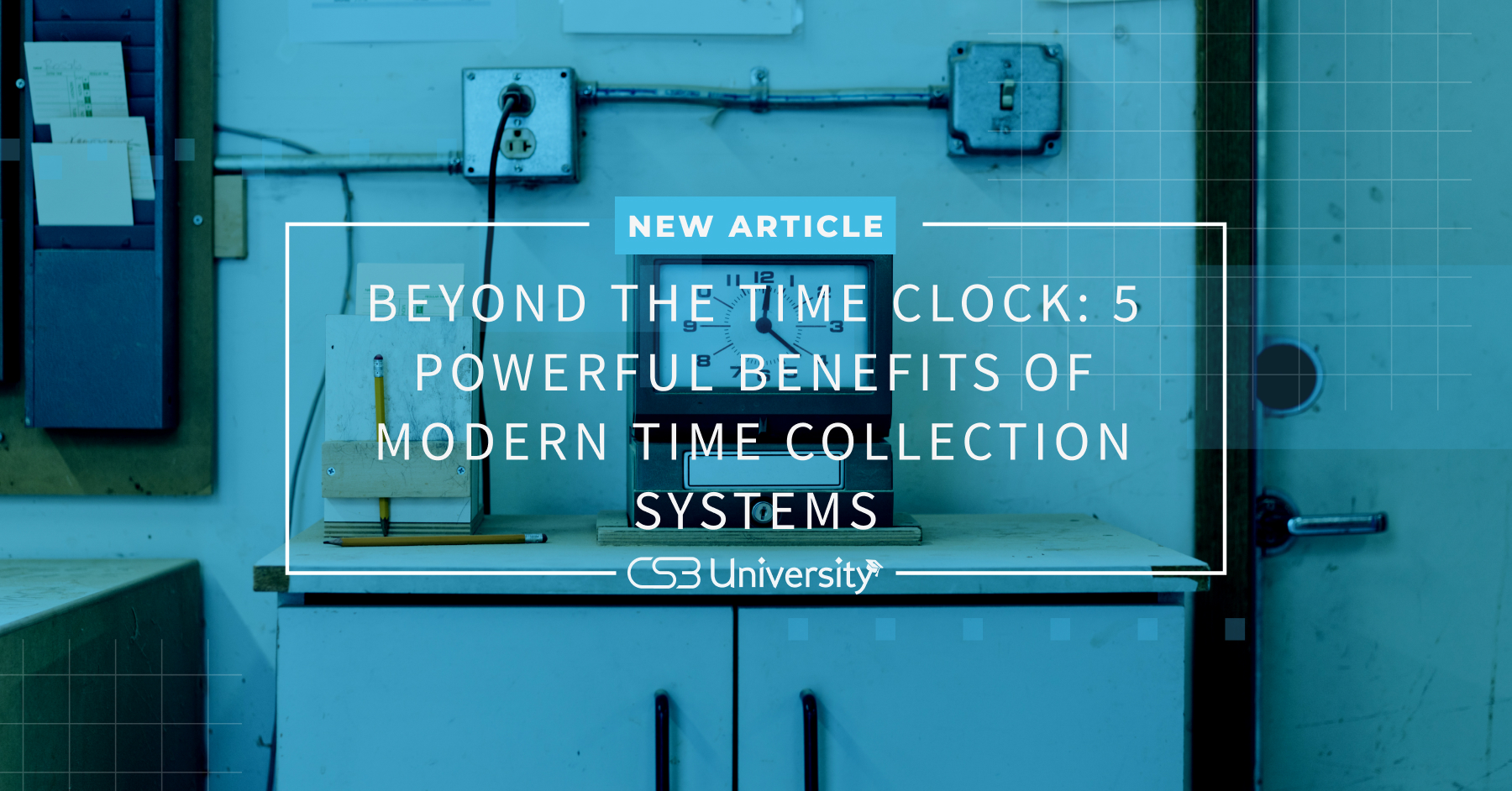Downloadable Resource
Blog
Webinar Recording
Success Story
Article
Technical Article
Video Insight
Trade Show
Webinar
Tutorial
Video Demo

Beyond the Time Clock: 5 Powerful Benefits of Modern Time Collection Systems
Join us on
July 27, 2025

Download Now
In today's competitive business landscape, managing employee time effectively isn't just about tracking hours—it's about optimizing your most valuable resource. With payroll typically representing the largest expense on most businesses' profit and loss statements, implementing a sophisticated time collection system can transform your workforce management strategy and deliver substantial returns on investment.
While traditional time collection might conjure images of employees simply clocking in and out, modern systems offer far more comprehensive capabilities. These advanced platforms provide powerful self-service functionality, detailed analytics, and streamlined processes that benefit both employees and management alike.
Let's explore the five most significant advantages that automated time collection systems bring to organizations of all sizes.
Event Details
Price:
$
USD
Location:
Virtual
Address:
1. Enhanced Accuracy and Fraud Prevention
Manual timekeeping processes—whether paper timecards or basic spreadsheets—introduce significant vulnerabilities into your payroll system. When employees record their hours days after they've worked them, memory lapses and human error naturally occur. Even more concerning, these honor-based systems can be susceptible to time theft.
Consider this revealing scenario: In an organization with 150 employees earning an average of $15 per hour, if each worker adds just 15 minutes to their timesheet each week, the annual financial impact reaches nearly $30,000. That's money that could be invested elsewhere in your business.
Beyond employee reporting issues, manual data entry by payroll staff introduces another layer of potential errors. Illegible handwriting, transposition mistakes, and simple typos can contribute to an estimated 3% error rate in payroll processing. For many organizations, this represents thousands or even hundreds of thousands of dollars in unnecessary costs.
Automated time collection systems eliminate these issues by:
- Capturing precise clock-in and clock-out times electronically
- Transferring data to payroll systems without manual intervention
- Alerting supervisors to irregular attendance patterns in real-time
- Creating audit trails that prevent retroactive time manipulation
- Enforcing consistent attendance policies across the organization
2. Dramatic Productivity Gains for HR and Payroll Teams
The traditional end-of-period payroll process consumes valuable hours with low-value administrative tasks. Your HR and payroll professionals spend countless hours chasing paper timecards, tracking down supervisors for approvals, reconciling time-off requests, deciphering handwriting, and manually entering data.
Modern time collection systems transform this inefficient process through automation and integration. By implementing an automated solution, your organization can:
- Eliminate duplicate data entry across systems
- Streamline approval workflows through digital routing
- Reduce payroll processing time by up to 70%
- Minimize day-to-day data maintenance requirements
- Free HR and payroll staff to focus on strategic initiatives
The productivity gains extend beyond just administrative efficiency. With accurate time data flowing automatically into your payroll system, you'll experience fewer payroll errors, reduced correction cycles, and more timely wage payments to employees.
3. Strengthened Regulatory Compliance
Wage and hour compliance represents a significant risk area for employers. Federal and state regulations require precise payment for all time worked, including overtime calculations that can become exceptionally complex with varying pay rates or work classifications.
Beyond basic wage requirements, many organizations face additional compliance obligations related to:
- Affordable Care Act (ACA) reporting requirements
- Employee benefit eligibility tracking
- State-specific meal and rest break regulations
- Family and Medical Leave Act (FMLA) administration
- Fair Labor Standards Act (FLSA) overtime provisions
While no system can guarantee perfect compliance, modern time collection platforms provide the consistent documentation and detailed reporting capabilities essential for demonstrating good-faith compliance efforts. Should your organization face a Department of Labor audit or wage claim, having detailed electronic records with punch-by-punch data can make all the difference in proving compliance.
4. Unprecedented Visibility into Labor Costs
In today's data-driven business environment, making decisions without complete information puts your organization at a competitive disadvantage. Advanced time collection systems provide granular insights into your workforce operations that manual systems simply cannot match.
These systems enable detailed analysis of:
- Job costing and departmental labor distribution
- Scheduled versus actual staffing levels
- Overtime trends and contributing factors
- Absenteeism patterns and associated costs
- Productivity metrics across teams and individuals
This visibility allows management to make informed decisions about staffing levels, identify operational inefficiencies, and implement targeted cost-control measures. Organizations that leverage these insights report saving up to 5% on their total payroll costs—a substantial return on investment that extends far beyond the administrative time savings.
With clearer visibility into exactly where labor dollars are being spent, organizations can optimize schedules, redistribute workloads, and address productivity challenges before they impact the bottom line.
5. Empowering Employee Self-Service
Modern time collection systems place greater control and transparency directly into employees' hands. Through self-service portals accessible via web browsers or mobile apps, workers can:
- Review their accumulated hours in real-time
- Submit time-off requests digitally
- Access their work schedules from anywhere
- View paid time off balances
- Verify that their time records are accurate before payroll processing
This self-service functionality doesn't just benefit employees—it significantly reduces the administrative burden on managers and HR staff. Rather than fielding constant inquiries about schedules, available time off, or pay period hours, these teams can redirect their focus to more strategic initiatives.
Additionally, by giving employees greater visibility into their own time records, organizations foster a culture of accountability and transparency. When workers can easily verify their own hours, they're more likely to take ownership of accurate time reporting.
The Measurable Return on Investment
Implementing an automated time collection system represents an investment that typically delivers rapid returns through multiple channels:
- Reduction in payroll errors and associated correction costs
- Elimination of time theft through accountability features
- Administrative time savings for HR, payroll, and management
- Decreased compliance risk and potential penalty avoidance
- Optimized staffing through improved visibility into labor utilization
For most organizations, these combined benefits translate to a complete return on investment within the first year of implementation, with ongoing savings continuing to accumulate thereafter.
Conclusion: Moving Beyond Basic Timekeeping
Modern time collection systems represent far more than just digital replacements for punch clocks. They provide comprehensive workforce management solutions that deliver accuracy, efficiency, compliance, visibility, and employee empowerment across your organization.
As labor costs continue to represent the largest expense for most businesses, implementing technology that optimizes this critical resource simply makes good business sense. The rapid and measurable return on investment makes automated time collection one of the most impactful technology investments available to today's forward-thinking organizations.
By moving beyond basic timekeeping to embrace the full capabilities of modern time collection systems, your organization can transform a necessary administrative function into a strategic advantage that delivers ongoing value throughout your operation.











